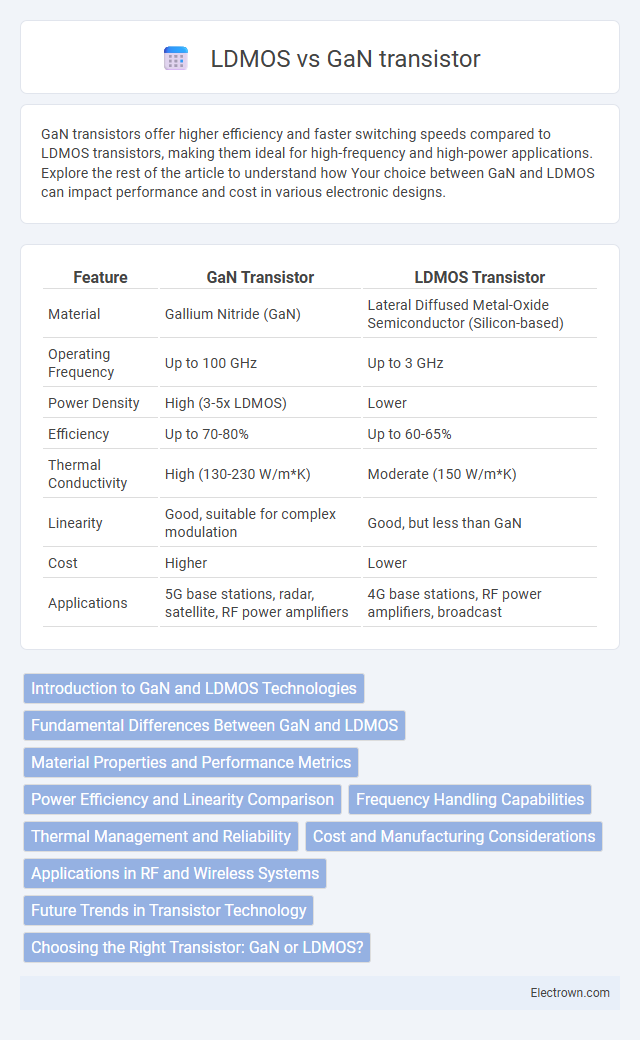GaN transistors offer higher efficiency and faster switching speeds compared to LDMOS transistors, making them ideal for high-frequency and high-power applications. Explore the rest of the article to understand how Your choice between GaN and LDMOS can impact performance and cost in various electronic designs.
Table of Comparison
| Feature | GaN Transistor | LDMOS Transistor |
|---|---|---|
| Material | Gallium Nitride (GaN) | Lateral Diffused Metal-Oxide Semiconductor (Silicon-based) |
| Operating Frequency | Up to 100 GHz | Up to 3 GHz |
| Power Density | High (3-5x LDMOS) | Lower |
| Efficiency | Up to 70-80% | Up to 60-65% |
| Thermal Conductivity | High (130-230 W/m*K) | Moderate (150 W/m*K) |
| Linearity | Good, suitable for complex modulation | Good, but less than GaN |
| Cost | Higher | Lower |
| Applications | 5G base stations, radar, satellite, RF power amplifiers | 4G base stations, RF power amplifiers, broadcast |
Introduction to GaN and LDMOS Technologies
GaN (Gallium Nitride) and LDMOS (Laterally Diffused Metal-Oxide Semiconductor) transistors serve distinct roles in high-frequency and power applications due to their unique material properties and design structures. GaN technology offers superior electron mobility and breakdown voltage, enabling higher efficiency and power density in RF and microwave amplifiers. In contrast, LDMOS transistors, built on silicon-based substrates, excel in cost-effectiveness and robustness for base station and broadband power amplifier uses, making your choice dependent on specific performance and economic requirements.
Fundamental Differences Between GaN and LDMOS
GaN transistors utilize wide bandgap semiconductor materials, offering higher electron mobility and superior power density compared to LDMOS devices based on silicon. This fundamental difference leads to GaN's ability to operate at higher frequencies with increased efficiency and greater thermal resistance, making it ideal for high-performance RF and power applications. Your choice between GaN and LDMOS should consider these contrasts in material properties, switching speed, and power handling capabilities.
Material Properties and Performance Metrics
Gallium Nitride (GaN) transistors offer superior electron mobility and higher breakdown voltage compared to LDMOS (Laterally Diffused Metal Oxide Semiconductor) devices, enabling higher efficiency and power density in RF and power applications. GaN's wide bandgap material properties support operation at higher frequencies and temperatures, resulting in improved gain and linearity over LDMOS transistors. LDMOS transistors, with mature silicon-based technology, typically provide lower cost and easier integration but fall short in power-added efficiency and output power at microwave frequencies relative to GaN devices.
Power Efficiency and Linearity Comparison
GaN transistors exhibit superior power efficiency compared to LDMOS devices due to their higher electron mobility and breakdown voltage, enabling faster switching speeds and reduced conduction losses. Linearity in GaN transistors remains high across wide bandwidths, supporting better signal fidelity in RF applications, whereas LDMOS transistors typically show reduced linearity at higher frequencies. These characteristics make GaN devices preferable for next-generation power amplifiers in telecommunications and radar systems where efficiency and linearity are critical.
Frequency Handling Capabilities
GaN transistors exhibit superior frequency handling capabilities compared to LDMOS transistors, operating efficiently at frequencies exceeding 30 GHz due to their higher electron mobility and wider bandgap material. LDMOS transistors, typically optimized for frequencies below 6 GHz, experience significant performance degradation beyond this range. This makes GaN technology ideal for high-frequency applications such as radar systems, 5G infrastructure, and satellite communications.
Thermal Management and Reliability
GaN transistors offer superior thermal conductivity compared to LDMOS, allowing more efficient heat dissipation and higher power density in compact designs. LDMOS devices typically exhibit better long-term reliability under continuous high-voltage operation due to their mature technology and robust semiconductor structure. Managing your system's thermal budget effectively ensures optimal performance and extends the lifespan of GaN or LDMOS transistors in power applications.
Cost and Manufacturing Considerations
GaN transistors generally exhibit higher initial manufacturing costs due to complex epitaxial growth and substrate expenses compared to LDMOS devices, which benefit from mature silicon processing and established production lines. LDMOS transistors offer cost advantages in high-volume applications due to lower raw material costs and well-optimized fabrication techniques. Advances in GaN semiconductor manufacturing, including improved wafer sizes and yield rates, are progressively reducing cost gaps, making GaN increasingly competitive in commercial RF power applications.
Applications in RF and Wireless Systems
GaN transistors excel in high-frequency, high-power RF and wireless systems due to superior electron mobility and thermal conductivity, enabling more efficient amplification and better linearity in 5G base stations and radar applications. LDMOS transistors remain dominant in cellular infrastructure and broadcast transmitters because of their cost-effectiveness and robustness under high voltage conditions. GaN's ability to operate at higher voltages and temperatures makes it ideal for next-generation RF power amplifiers demanding enhanced performance and energy efficiency.
Future Trends in Transistor Technology
GaN transistors outperform LDMOS devices in power efficiency and frequency handling, driving their adoption in 5G base stations and radar systems. Future trends emphasize GaN's potential for higher power density and thermal management improvements, expanding applications in electric vehicles and aerospace. LDMOS technology continues evolving with enhanced linearity and cost-effectiveness, yet GaN's superior performance makes it the cornerstone of next-generation high-frequency power amplifiers.
Choosing the Right Transistor: GaN or LDMOS?
Choosing the right transistor between GaN (Gallium Nitride) and LDMOS (Laterally Diffused Metal Oxide Semiconductor) depends on your application's power efficiency and frequency requirements. GaN transistors offer higher electron mobility, enabling superior performance in high-frequency and high-power scenarios, making them ideal for 5G infrastructure and radar systems. LDMOS transistors excel in cost-effectiveness and robustness at lower frequencies, often preferred for traditional RF amplifiers and base stations.
GaN vs LDMOS transistor Infographic

 electrown.com
electrown.com